|
Edited
by Frank R. Shaw, FSA Scot, Dawsonville, GA, USA
Email:
jurascot@earthlink.net
Just over two years ago, Ross
Roy and I began discussing a very important matter to him. He wanted to tell
the story of his grandfather, W. Ormiston Roy, and he wanted his narrative
to be shared within the pages of Robert Burns Lives!. His logic, as always,
was simple and to the point. He wanted his account put on the Internet so it
would be available to people for years to come. Ross wanted to share with
the world his story about a most remarkable man and one that any Scottish
journal would be honored to print, and so am I!
In our many conversations, mostly about Burns, rare books about Burns, eBay,
new books on Burns, our Burnsian friends, etc., Ross would inevitably
mention something about his grandfather. He enjoyed telling me of the
influence his grandfather had on him and he liked sharing stories of their
trip to Scotland together when Ross was an eight-year-old lad. More than
likely he would briefly smile or his eyes would sparkle when talking abut
his grandfather. There was never any doubt of the admiration, respect and
love Ross had for his grandfather. Having never known either of my
grandfathers, or grandmothers for that matter, I was always impressed and in
awe of the close relationship of these two men.
In this introduction, I’d like to pay tribute to several sources in the
preparation of this article beginning with Ross’s own typing of notes on his
old electric IBM memory typewriter. It is especially noteworthy to mention
that this is one of Ross’s last writings before his untimely death. Patrick
Scott mentioned in an email to me recently that this article was “long
promised to you”. When Ross reached the point where typing became a chore,
he began dictating his thoughts to Ms Sej Harman, renowned for her outstanding
work in Studies in Scottish Literature. The story went through several
additional revisions and was still unfinished at the time of Ross’s death.
Soon after, Patrick Scott pitched in to complete the editing. Patrick also
added the quotation from Ormiston Roy’s essay about Burns and supplied
further biographical details. I’m particularly indebted to Ross’s dear wife,
Lucie, for her permission to share Ross’s story with our readers. All
illustrations are from the Roy Collection at the University of South
Carolina. My deepest thanks to one and all! (FRS: 5.23.13)
W. Ormiston Roy as Remembered by his
Grandson
by G. Ross Roy
It was through my
grandfather, W. Ormiston Roy (1874-1958), a landscape gardener,
horticulturalist, and book collector, that I first became acquainted with
Robert Burns. My relationship with him spread over twenty-six years, from
the early nineteen-thirties, to the late nineteen-fifties, and what follows
is not a formal biography, but my memories of him during those years with
some background information about him added about his career and his
interest in Burns.
William Ormiston Roy was born
in Montreal in 1878 and spent all of his life there. He was proud to share
a birthday with Winston Churchill; they exchanged letters, and like
Churchill he was photographed by the famous Canadian photographer Yousuf
Karsh. Though friends called him Willie, he signed himself W. Ormiston Roy;
he told me that initially he had used William O. Roy, but that people began
calling him Mr. O’Roy, thinking that he was Irish. So he began to use the
more formal signature (abbreviated below to WOR). One of thirteen children,
he was obliged to go to work when his father, a gardener, died. He joined
the staff of the Mount Royal Cemetery, Montreal’s Protestant burying ground,
where he remained throughout his working career.
In 1892, he married Charlotte
Sprigings, daughter of the cemetery’s Superintendent. Among the books that
I later inherited was one of her first gifts to him, before they were
married, for Christmas 1890. This was a volume of Burns inscribed to her
“friend” Ormiston Roy. .
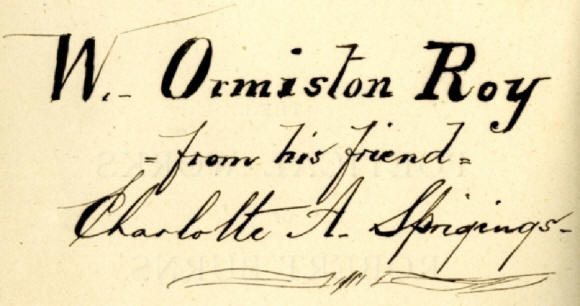
My grandmother’s inscription, Christmas 1890
They had five children, but
only three reached maturity. When his father-in-law died, WOR became
Superintendent. Early in life, he became interested in landscape
architecture, and he transformed the Mount Royal Cemetery into one of North
America’s most beautiful cemeteries. In this, he was influenced by the
ideas of the Boston landscape architect H.W. Sargent and his cousin the
botanist Charles Sprague Sargent. He was also a firm believer in cremation,
and arranged to have Canada’s first crematorium built. To mark the Mount
Royal Cemetery’s 150th anniversary, the cemetery and McGill-Queens
University Press issued a very attractive book about its history, in which
William Ormiston Roy plays a prominent role.
Probably based, in part, on
what he had done to the Mount Royal Cemetery, WOR began to develop a
landscape business with private clients and businesses, taking on outside
consulting commissions. But he never founded his own company, always
working as an independent. Among other clients, he worked for the Prime
Minister of Canada, Henry Lyon Mackenzie King, for the nature writer (and
Whitman enthusiast) John Burroughs in upstate New York, and on Henry Ford’s
property at Dearborn, Michigan. Rather than take a fee from Ford, WOR had
an agreement that when he was in Great Britain, which he visited annually,
the Ford Company would supply him with a car and driver.
This is where I come into the
story. In 1932, when I was eight years old, my grandfather asked my parents
if they would allow him to take me along with him to Great Britain. They
agreed, and this trip started a relationship which lasted until his death in
1958. One of the highlights of the trip for a boy was being allowed, in
Stirling, to hold in his hand William Wallace’s sword—it was much too heavy
for me to brandish. It was on this trip that WOR purchased Robert Burns’s
wooden porridge bowl, now in the Roy Collection (see
http://www.electricscotland.com/familytree/frank/burns_lives69.htm for a
photograph and description).
My grandfather knew several
of the leading writers and poets in Scotland, and so at an early age I
received an introduction to current Scottish literature and developed what
has remained a continuing interest of mine to this day. One visit was to the
Scots-language poet Charles Murray, author of Hamewith (1900), which
includes his poem “Gin I was God,” where God looks down at humanity and
decides to start again. (Mrs. Murray took one look at me and said, “That
boy hasn’t washed behind his ears since he left Canada,” whereupon I was
whisked into the Murrays’ bathroom and thoroughly scrubbed.) During the
trip, I was made to memorize several contemporary Scottish poems which I had
to recite later when I returned home. I was also outfitted with a tweed
jacket and kilt which I unwillingly wore back home on special occasions.
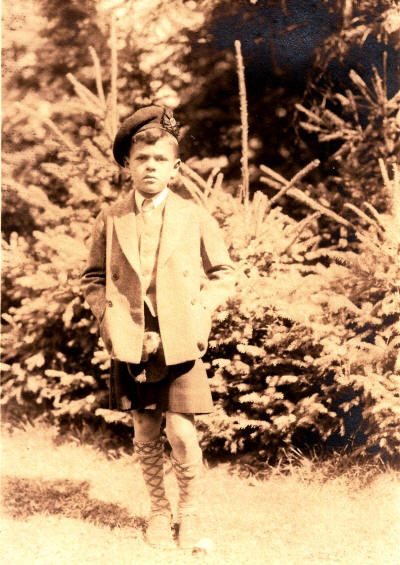
G. Ross Roy, ca. 1932
I recall that we spent
several days at Queensferry Inn, and I enjoyed going down to the wharf to
see the ferry come and go. Although he never told me so, I think that my
grandfather tired somewhat of the constantly questioning eight-year-old, and
he took me down to London to stay with Aunt Annie. We were distantly
related, and she too had worked for the Mount Royal Cemetery, moving to
London upon retirement. She was a gentle soul and went to great pains to
entertain me. All things come to an end, however, and my grandfather and I
sailed from Southampton to New York and home to Montreal.
It was on trips to Scotland
such as this that WOR got to know many of the leading Burnsians of the
interwar period, including John McVie, then secretary of the Burns
Federation, and Duncan M’Naught. In the later 1930s, he was one of those
involved in trying to help the German Burns scholar Hans Hecht when he had
been deprived of his professorship at Gottingen by the Nazis and came to
Scotland as a political refugee.
WOR was a person of wide
interests. He bred collie dogs and once won best of show at New York’s
Westminster Kennel Club, the most important American show. He won trophies
at the winter sport of curling. He also won the Banks Medal from the Royal
Horticultural Society at Kew Gardens in London.
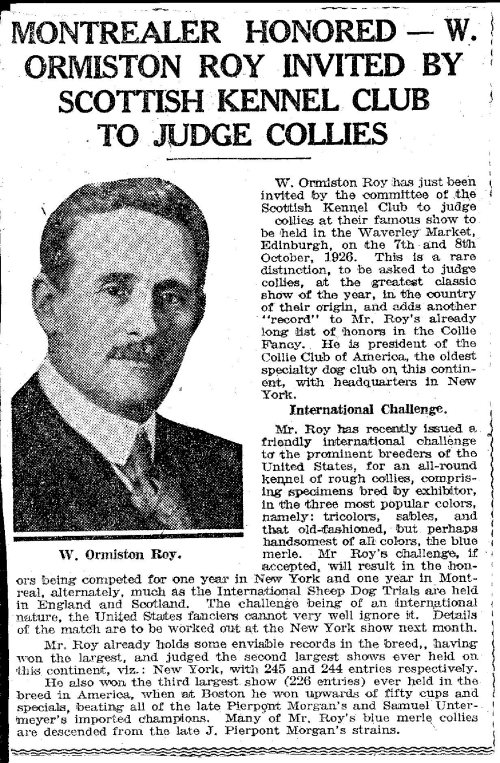
W. Ormiston Roy in mid-life
As a landscape architect, or
“landscape Naturalist” as he liked to call himself, he had an intimate
knowledge of trees, shrubs and flowers. In the 1920s he started planting
peonies, and in 1927 or 1928 my father joined him. He had extensive fields
in the Montreal area as well as farms in Champlain, NY, and Uniontown,
Alabama. In 1935, he took my sister Anne and me with him down to Uniontown
when he went to oversee the harvesting of the peonies. I was allowed to
leave school for an extended period provided I kept a diary. I still have
the diary, and it makes interesting browsing. For instance, I met the
agricultural scientist Dr. George Washington Carver, of Tuskegee, famous for
encouraging the growth of peanuts and the uses of peanut butter.
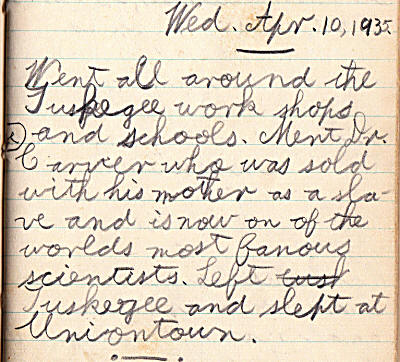
Diary entry about meeting Dr. George Washington
Carver, 1935
During my school years, I
lived with my parents, moving with them out to the suburbs of Montreal. When
I returned to university, after war service as a Navigator in the Royal
Canadian Air Force, on loan to the Royal Air Force, I was faced each day
with a train ride, followed by a streetcar ride and then a bus ride. My
grandfather lived walking distance from the university, and by then had lost
his wife, my grandmother, so I moved in with him. In exchange for driving
him, he let me use his car. The driving was really very pleasant because
WOR had taken to visiting the Gaspé area in the summer to escape ragweed.
We usually stayed in the houses of fishermen-farmers. We would go out for a
day in one of the small fishing boats. Most of the catch was then dried on
racks. WOR mixed easily and we soon became almost residents of the various
villages in which we stayed. I learned a valuable lesson from him—how to
associate with people of all classes.
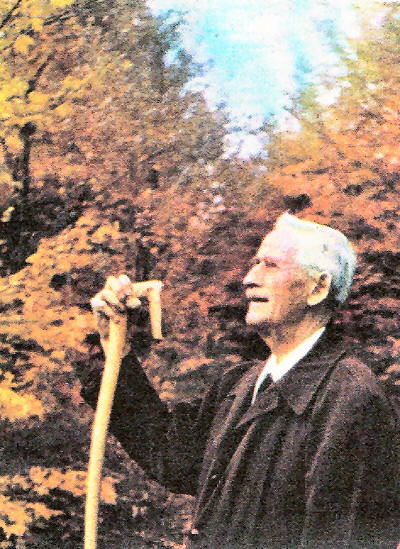
W. Ormiston Roy in later life
We both did our own cooking;
mine was just ordinary food. WOR lived on a self-imposed odd diet composed
of “healthful” meals. He scornfully claimed I was “digging my grave with my
teeth.” Ironically, I am now older than he was when he died.
Although he pretended to mock
me for attending university, he was proud of me, and spoke highly of me to
others when I was not around. He liked to quote Burns on a college
education when the bard said of those who went to “college-classes” that
they “gang in stirks [bullocks] and come out asses.”
WOR collected books on a
variety of topics, and it was from him and a couple of other people that I
learned how to collect as well as the joy of the chase. But he not only
collected books, he read them. At mealtime and when I was driving him we
very frequently discussed literature. This was a new experience to me.
Both my parents read and my maternal grandmother had quite a large library,
but to them reading was a personal activity, not discussed with others. And
so when I moved in with my grandfather, I entered a whole new world.
WOR preferred poetry to
prose, and this was reflected in his collecting, although there would have
been plenty of room for fiction in his large house. He was not particularly
fond of Shakespeare, although he had a set of Hamilton Wright Marbie’s
eleven-volume Shakespeare, which I still have. I cannot tell which, if any,
of the plays he read because none of the volumes is marked. In other
instances, WOR annotated books he owned, usually at the back. These
comments make fascinating reading, showing a keen intellect at work.
Soon after I moved in, the
topic turned to Robert Burns and as long as I was with WOR the conversation
constantly included references to the poet. My grandfather knew Burns and
could quote him at will. He once told me that he had never had an
experience in life for which he was unable to find an appropriate quotation
from Burns. And so for several years, I was regaled by sometimes very witty
quotations from the poet. I also helped him find books to add to his
collection. By then, WOR was elderly, so I usually visited the bookshops on
my own, but I was happy to have my grandfather pay for books I found.
Unlike many Burnsians, WOR
could claim that in forty years he had never given a talk about Burns. His
only surviving written comments about the poet are a short typescript from
after World War II, explicitly influenced by William Stewart’s pre-World War
I book on the same topic, in which WOR praises Burns as the first poet to
discover the importance of the Common People:
“This is part of the real
abiding service which Burns rendered to humanity. He saw them as no one else
had ever seen them; as they had not even seen themselves. He was the first
to say “:A man’s a man for a’ that”--...What a discovery! The power of man!
Compared to this, the explosion of an atom bomb appears like a noisy stunt.
“While there is no poet—who
is so truly a national poet, yet there is none who has done so much to break
down national boundaries and destroy racial antipathies....In these days,
all kinds of people seek to associate themselves with the name of Robert
Burns, but no opponent of liberty—no traitor to democracy has the right to
claim that Burns is on his side.”
One could not be with Willie
without some of this infectious enthusiasm rubbing off, and before long I
became interested in Robert Burns. Two-thirds of a century have elapsed but
the interest has not waned. When I was accepted at the University of Paris
(Sorbonne) I proposed a thesis on Burns but was told that there was already
one—Auguste Angellier’s. And so my academic interest in Burns was put on
hold.
WOR also collected the poetry
of Walt Whitman, and when I took a degree at Strasbourg, I included Walt
Whitman in my thesis. At this point my grandfather gave me a volume of
Whitman, the “Birthday Edition” from 1889, which the poet had inscribed to
the critic Edward Dowden and which had been reinscribed owner by owner till
it came to WOR. It is a lovely book, now housed in the University of South
Carolina.
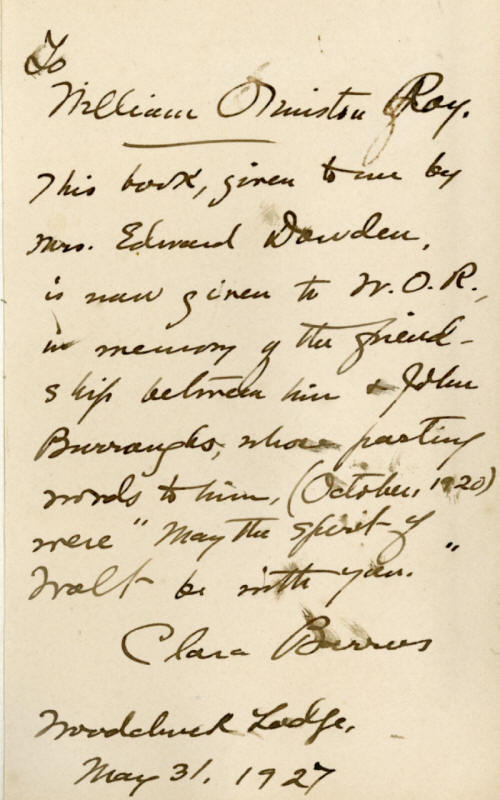
The Birthday edition of Whitman’s Leaves of
Grass, inscribed to WOR
My grandfather had a
considerable library which reflected his interests. Naturally Burns played
a major role in the collection. He told me that he purchased a Kilmarnock
edition in 1939 for ₤100. He sent it to a Burns expert for verification.
Meanwhile World War II broke out and he had to leave for home as rapidly as
possible, without the Kilmarnock. Some time after 1939 he tried to contact
the person to whom he had sent the volume. Unfortunately the man had died,
and the family treated WOR like a charlatan who was trying to make off with
a prized book. He was dead before I bought my copy to replace it.
While in Strasbourg I met
Lucie Jehl, and we were married there in 1954. My parents had been in an
automobile accident and my father was unable to travel. In order to have a
family member there, my grandfather agreed to come over, and he served as my
witness in the civil wedding which had to precede a religious wedding in
France. When Lucie and I left Strasbourg and moved to Montreal, we saw my
grandfather quite frequently. He had specially liked Lucie’s cheese soufflé,
and he would check she was going to cook it before inviting himself over for
dinner.
In 1956 we returned to France
for me to work on my doctorate at the Sorbonne. WOR came over to Europe to
attend the first meeting of the Food and Agriculture Organization in Rome.
He was very interested in drying food for shipment to underprivileged
countries, and he talked up his idea to the FAO delegates. While in Europe,
he visited in Strasbourg for a couple of days, and when he went to the
station to catch his train for Paris, Lucie and I went along to the
station. We parted with a handshake. Nothing was said, but somehow we both
knew that we would not meet again. I returned to my in-laws and wept.
WOR died in 1958. Lucie,
Madeleine and I were already on our way home to Canada when a telegraph
reached me telling me this. I believe that he was trying to hold out until
I arrived. Those present when he passed away told me that the last word
that he uttered was my name.
My grandfather left a
considerable estate which went to his two living children—my uncle William
Wallace and my father Archibald Carlyle. The one item treated differently
from the general estate was his library, which he left to me.
The different groups of
books, sometimes very large, were divided up and dispersed in various ways.
An important group of horticultural volumes was gifted to the Montreal
Botanical Garden. I kept the general literature for myself. But the
collection was still too large, so I held an auction among graduate students
and donated the proceeds to the Cancer Society, because that was the disease
from which WOR had died.
What interested me most in
what I had inherited was the Scottish literature, particularly the Burns
books. One could say that the Roy Collection began in 1958, with that
inheritance, but I date the collection’s beginning back to 1890, when my
grandmother gave WOR the book previously mentioned. Even though I had
helped WOR build it, I was astonished by the collection of which I had
become the proud owner. Several packages containing books purchased by WOR
when he was over for my wedding had not even been opened. There was of
course no longer a Kilmarnock edition, but I believe there were already
seven 1787 editions.
Slowly I began to sort
through the material. This was not an easy task because in 1958, before
Egerer’s Burns bibliography, there was no comprehensive guide to identifying
Burns editions and no way of knowing exactly what had been printed. Partly
for reasons of space, I sold my own collection of Canadian literature and
used the proceeds to buy a Kilmarnock to replace the one he had lost. Today
Kilmarnocks rarely come up for sale, but in 1961 when I wanted one, I wrote
to three Scottish dealers and was offered two by return mail. I paid a good
deal more than the ₤100 my grandfather had paid, but far less than the
selling price of a Kilmarnock today. I have gone on adding to the
collection, which is now six or more times bigger than the one I inherited.
I like to think back on the
things I have done with WOR and the gifts I have had from him, going from
the eight-year-old boy walking the deck of a steamer to that last handshake
at the railway station in Strasbourg. Of all the gifts my grandfather gave
me over a long life, the greatest was his love. Many years later, after I
transferred the Burns collection to the University of South Carolina, Lucie
and I established a W. Ormiston Roy Visiting Fellowship named for him for
scholars to come and work on Burns. Later still, as the frontispiece in the
published catalogue to the Burns collection, I chose the Karsh portrait of
my grandfather.
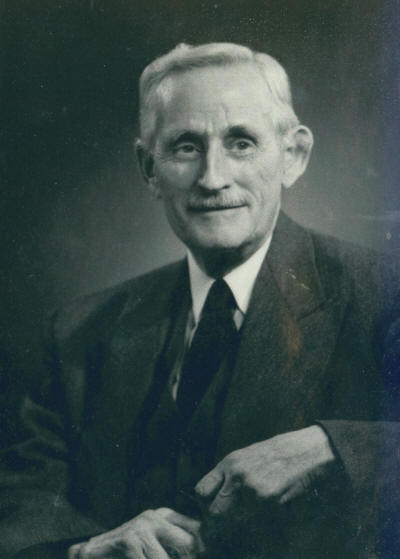
W. Ormiston Roy, by Yousuf Karsh
|

